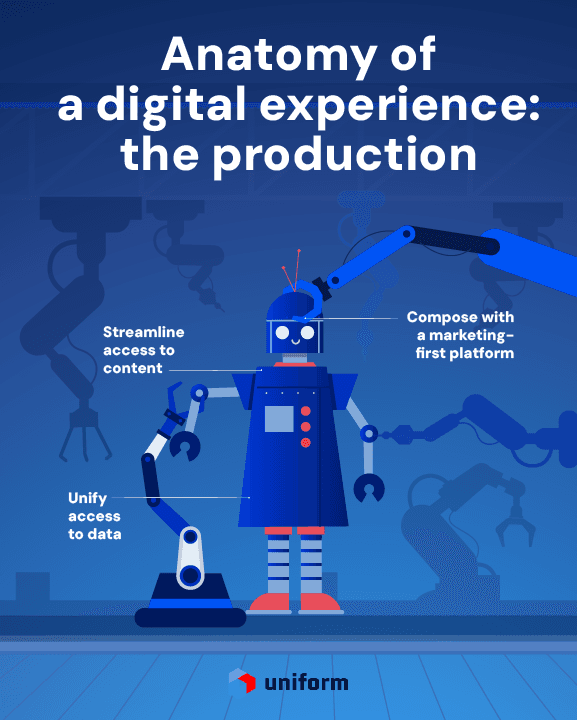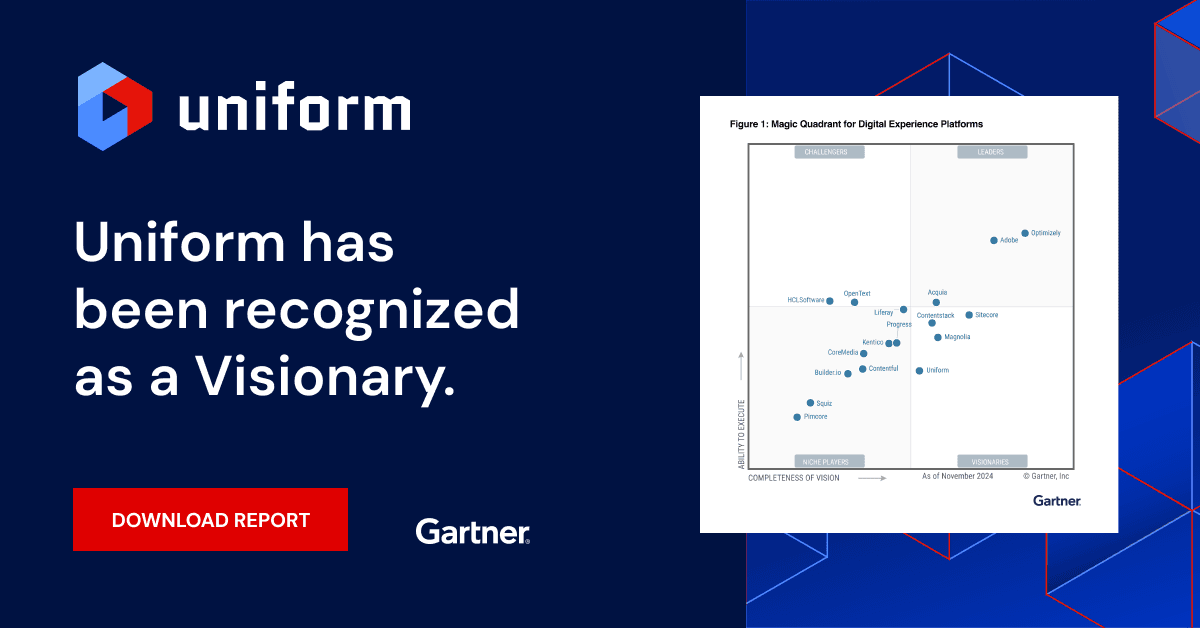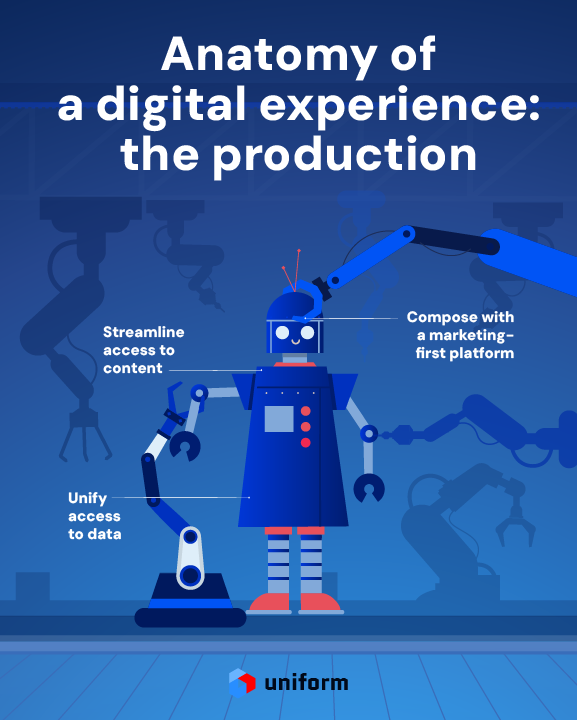Uniform blog/Anatomy of a digital experience part 2: the production
Anatomy of a digital experience part 2: the production
Anatomy of a digital experience part 2: the production
Before the digital age, price and product were the reigning differentiators for brands. Now, the digital experience, paired with an effective omnichannel strategy, is the baseline for winning customer loyalty. In fact, brands that prioritize customer experience see higher revenues compared to industry peers that do not.
Nevertheless, transforming a strategy into a consistent, cohesive customer experience requires more than just meticulous planning. Brands need to unify content, data, and technology, simplify access to them, and empower their creators with tools that accelerate content development and deployment.
In part two of our series, we examine how streamlining access to aggregate content and data inside a marketer-centric platform lays the groundwork for composing a high-performing digital experience.

1. Streamline access to content
Considering the sheer amount of content shared between brands and consumers, it’s no wonder content is described as the “currency” of digital experiences. Whether you’re promoting a blog or a new product, a brand’s content plays a pivotal role in fueling thought leadership, SEO, web traffic, and lead generation, which ultimately drives revenue.
In large organizations, content is typically dispersed across multiple sources: content management systems (CMSs), search engines, customer data platforms (CDPs), digital asset management systems, product information management platforms, as well as other products and bespoke systems. These sources feed the digital experiences we publish; as brands expand to omnichannel engagement, the need for these technologies to support more devices and channels can test the limits of a rigid architecture.
Still today, many brands rely on their CMS to serve as the presentation layer of their web properties. This CMS-centric (thus content-first) approach is difficult to manage and scale over time for several reasons:
- CMSs have a specific way of managing content, which can become a limitation as business and customer demands evolve.
- Traditional CMSs are tightly-coupled, proprietary systems that are costly to maintain. Integrations with third-party vendors and tools are time-intensive as they rely on considerable developer code and support.
- With the CMS at the center of the tech stack, other back-end systems, applications, and tools must flow through it. Therefore, experience creation starts with the CMS—and the content inside of it—instead of building content to optimize the ideal experience.
Being competitive in a fast-moving market means developer support is crucial to leveraging content from any source. However, if you were to utilize a front-end presentation solution that integrates with APIs across all of your sources, including the CMS, you could eliminate code from the experience production process altogether.
2. Unify access to actionable data
If content is the currency of digital experiences, data gives this currency value. Data is essential to reaching your target audiences and anticipating customers’ wants and needs as they travel along the buyer’s journey.
Survey after survey reveals marketers struggle to deliver engaging experiences because they lack a clear view of their customers. Among their top challenges, 63 percent of marketers say leveraging integrated customer data for digital marketing remains an obstacle.
While finding, storing, and organizing enterprise data is its own obstacle for enterprise marketers, discovering ways to analyze and extract useful insights for digital experiences is even more daunting without the right tools and integrations. Given more than 80 percent of IT leaders point to data silos as a major obstacle in digital transformation, having the right technology to gather and consolidate clean, quality data is critical to accurate customer segmentation and personalization efforts.
For instance, take a digital ad about smartphones retargeted to potential customers. Knowing the difference between site visitors who’ve already purchased the product and prospects looking to buy a new smartphone is essential to grow revenue. Delivering targeted experiences based on this data, however, is key to improving ROI.
Like content, company data comes from different sources like a CDP and account-based marketing solutions. Campaign data should also be bidirectional, allowing a seamless sharing of information between these systems, and must be readily available inside the platform marketers use to optimize campaigns to provide a richer, more meaningful digital experience.
3. Compose with a marketing-first platform
The creator of digital experiences must be able to work with their organization’s content and data without relying on developers to write code to connect it to every component. They need the agility to swiftly respond to market trends and recalibrate experiences based on what’s working.
Ultimately, having more control over when, where, and how digital experiences are published enables brands to get to market faster and stay competitive.
Creating in a marketer-first platform, such as the visual workspace, versus building experiences inside of a CMS or CMS’s version of a DXP gives the marketer many distinct advantages:
- They have full control over the look and feel of their experiences from creation to publication, with accurate visual context along the way.
- They have centralized access to content and data from multiple sources, including actionable behavioral information they can apply by channel.
- They have access to native tools, like personalization and A/B testing, along with the freedom to integrate any and every other tool (e.g., generative AI) they need to make for a complete, single-browser tab workspace.
In practice, the collective go-to-market technology stack should maximize your digital team’s talents by connecting to and supporting all systems that drive cross-channel digital experiences. By removing unnecessary coding from production workflows, brands can offer their marketers true autonomy to launch campaigns without delaying publication or exhausting development resources. Creators should be free to experiment and perfect in a safe workspace that was designed just for them.
The foundation of fast digital experience production
Laying the blueprint for a compelling customer experience is the first phase in building the digital experience machine that executes an omnichannel strategy. The next phase is navigating the best technological path to feeding that machine using enterprise-wide content and data where and when it matters most while ensuring marketers work in an environment that lets them perform at their best.
In the final installment of our series, we’ll take our digital experience machine to market. Stay tuned.






.png&w=1080&q=90)
.png&w=1080&q=90)
.png&w=1080&q=90)